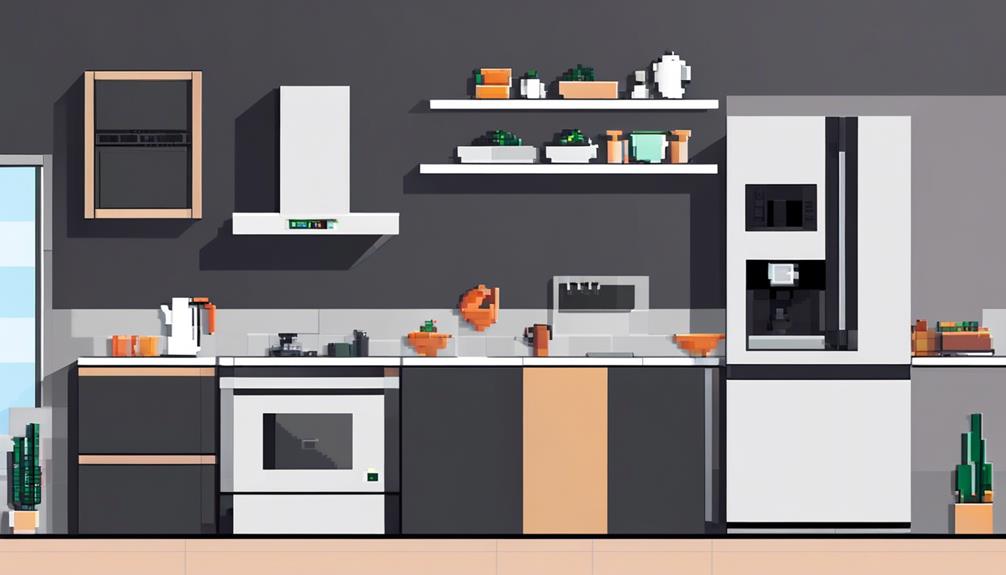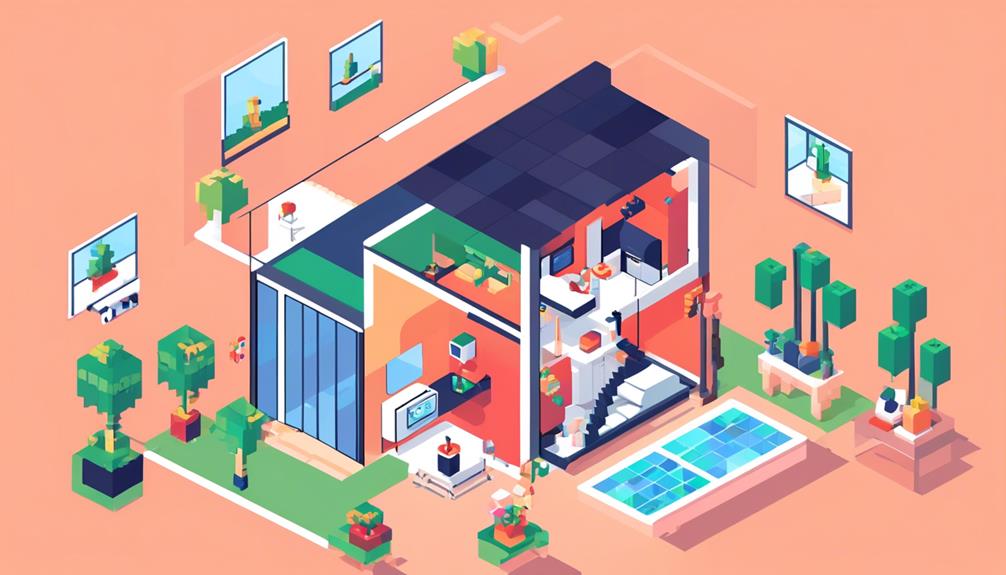The integration of Internet of Things (IoT) hardware into smart home automation has revolutionized the way we interact with our living spaces. From smart locks and motion sensors that enhance security to smart heating solutions that optimize energy consumption, these IoT devices offer a level of convenience and control that was once unimaginable.
But the possibilities don't stop there. With advancements in technology, we now have smart gardening solutions that ensure our plants thrive, personal assistants that seamlessly manage our daily tasks, and environmental controllers that create the perfect ambiance. And this is just the beginning.
In this discussion, we will explore the diverse range of IoT hardware available for smart home automation, uncovering how these devices are reshaping our homes and lifestyles.
Key Takeaways
- Smart home security and automation systems utilize smart locks and motion sensors to enhance home security and automate various tasks.
- Integration with other IoT devices allows for comprehensive smart home automation, providing homeowners with real-time alerts and notifications.
- Smart heating solutions and integration with smart home hubs and voice assistants optimize energy consumption and provide convenient control for personalized temperature adjustments.
- IoT-enabled devices and sensors enable efficient gardening and water conservation, monitoring soil moisture levels and providing real-time data for informed decision-making.
Smart Locks and Motion Sensors

Smart locks and motion sensors play a crucial role in enhancing home security and automation in smart home setups. Smart locks provide enhanced security by allowing keyless access to homes, eliminating the need for traditional keys. With features like remote locking and unlocking, homeowners can conveniently control access to their homes from anywhere.
Motion sensors, on the other hand, detect movement and trigger automated responses in smart home setups. These sensors can be used to activate lights, alarms, or send notifications based on movement, ensuring that homeowners are aware of any activity in their homes.
The integration of smart locks and motion sensors enhances overall home security by providing real-time alerts and notifications to homeowners. With the ability to monitor and control access to their homes remotely, homeowners can have peace of mind knowing that their homes are secure. Additionally, smart locks and motion sensors can be seamlessly integrated with other IoT devices, allowing for a comprehensive smart home automation system. This integration enables homeowners to create customized routines and scenarios based on their preferences and needs.
Apart from enhancing home security, smart locks and motion sensors also contribute to energy efficiency in smart homes. Motion sensors can be used to automate lighting and HVAC systems based on occupancy, ensuring that energy is not wasted when rooms are unoccupied. This not only reduces energy consumption but also enhances the overall smart home experience by providing convenience and energy savings.
Smart Heating Solutions
IoT-connected heating systems revolutionize temperature control and automation in smart homes, providing enhanced energy efficiency and personalized comfort. These smart heating solutions integrate seamlessly with the home automation system, allowing users to remotely control and automate their heating systems.
Here are four key features of smart heating solutions powered by IoT technologies:
- Energy Efficiency: Smart heating solutions optimize energy consumption by adjusting temperature settings based on occupancy and weather conditions. They can learn user preferences and adapt heating schedules accordingly, resulting in significant energy savings and reduced utility bills.
- Seamless Integration: These IoT-enabled heating systems can be integrated with smart home hubs and voice assistants, such as Amazon Alexa or Google Assistant. This integration enables users to control their heating systems using voice commands or through a mobile app, providing convenience and ease of use.
- Personalized Comfort: Smart heating solutions offer personalized temperature adjustments, allowing users to set individual preferences for different rooms or zones. This level of customization ensures that each occupant can enjoy their desired comfort level, enhancing overall satisfaction.
- Real-time Monitoring and Safety: IoT technologies enable real-time monitoring of heating systems, providing users with alerts and notifications in case of any issues or malfunctions. This ensures optimal and safe heating conditions, giving homeowners peace of mind.
Smart Gardening Solutions

Smart gardening solutions encompass a range of IoT-enabled devices and sensors that aim to automate and optimize gardening tasks.
Watering automation systems ensure efficient water usage by monitoring soil moisture levels and adjusting watering schedules accordingly.
Soil monitoring devices and plant health sensors provide real-time data on soil conditions and plant health, helping gardeners make informed decisions about plant care.
Watering Automation
Watering automation in smart gardening solutions leverages IoT technology to deliver efficient and targeted watering based on real-time data analysis of soil moisture levels and weather forecasts. By integrating smart home devices with automated watering systems, users can control and monitor their garden's watering needs remotely through smartphone apps.
Here are four key aspects of watering automation in smart gardening solutions:
- Optimal Water Usage: IoT-enabled systems optimize water usage by providing the right amount of water at the right time, preventing overwatering and water waste.
- Real-time Data Analysis: Sensors embedded in the system continuously monitor soil moisture levels and plant health, providing real-time data for proactive care and adjustments to watering schedules.
- Remote Control: Users can adjust watering schedules and settings remotely, ensuring plants receive adequate water even when they are away from home.
- Notifications and Alerts: Smart gardening solutions can send notifications and alerts to users about watering needs, ensuring plants receive timely attention and care.
Through the automation of watering processes, smart gardening solutions enhance the efficiency and effectiveness of plant care, while conserving water resources.
Soil Monitoring Devices
Soil monitoring devices play a crucial role in optimizing plant growth by providing real-time data on moisture levels, temperature, and light intensity. These devices are an integral part of smart gardening solutions in the realm of IoT and smart home automation.
By integrating soil monitoring devices with smart irrigation systems, automated watering can be achieved based on the specific needs of the soil and plants. Moreover, these devices offer mobile app integration, allowing users to remotely monitor and adjust the soil conditions for their plants. This not only helps in preventing overwatering or underwatering but also leads to healthier plants and efficient water usage.
Furthermore, advanced soil monitoring devices provide predictive analytics, offering insights into plant health and growth patterns based on historical data.
Plant Health Sensors
To ensure optimal growing conditions for plants, smart gardening solutions incorporate plant health sensors that monitor essential factors such as soil moisture, light levels, and temperature.
These sensors are connected to a smart home system, allowing users to receive real-time alerts and adjust watering or lighting schedules remotely.
Smart gardening solutions use data from plant health sensors to provide personalized care recommendations and insights for plant growth and maintenance.
By integrating plant health sensors into a smart home setup, users can automate watering, adjust lighting, and ensure the overall health of their indoor or outdoor plants with minimal effort.
Plant health sensors contribute to sustainable gardening practices by helping users conserve water, reduce energy consumption, and minimize plant stress through data-driven decision making.
Personal Assistants

Voice-controlled personal assistants, such as Amazon's Alexa and Google Assistant, have become an integral part of smart homes. They offer seamless integration with various smart devices, providing users with the convenience of controlling their devices through voice commands. This allows users to adjust settings, play music, and perform a myriad of tasks hands-free.
These personal assistants have the ability to understand natural language and are integrated with a wide range of third-party platforms. As a result, they continue to enhance the smart home experience, making daily activities more streamlined and efficient.
Voice-Controlled Personal Assistants
Personal assistants, such as Amazon's Alexa, Google Assistant, and Apple's Siri, are voice-controlled devices that utilize natural language processing to execute a wide range of tasks and provide information based on voice commands. These voice assistants play a significant role in the Internet of Things (IoT) ecosystem, enabling seamless control and automation of smart home devices.
Here are four key aspects of voice-controlled personal assistants:
- Hands-free control: Voice assistants allow users to control various smart home devices without the need for physical interaction, enhancing convenience and accessibility.
- Integration with smart home systems: Personal assistants can be integrated with smart home systems to control lighting, thermostats, and other connected devices, providing users with centralized control.
- Personalized responses: These voice-controlled devices can provide personalized responses based on user preferences and past interactions, creating a more tailored and intuitive user experience.
- Security: Voice assistants incorporate security measures to protect user data and ensure secure communication between the device and other IoT devices in the smart home ecosystem, safeguarding against potential vulnerabilities.
Integration With Smart Devices
Integration with smart devices is a crucial aspect of personal assistants. Personal assistants such as Amazon's Echo and Google Home allow for voice control of smart home devices. By linking smart devices with personal assistants, users can control their lights, thermostats, security systems, and other IoT devices through simple voice commands.
This integration expands the functionality of smart devices and eliminates the need for manual operation. It provides a more convenient and hands-free experience for users. With the integration of personal assistants, smart homes become more accessible and user-friendly, enhancing the overall experience of living in an IoT-enabled environment.
Environmental Controllers
Environmental controllers in IoT hardware play a crucial role in regulating and managing factors such as temperature, humidity, and air quality in smart home environments. These controllers enable precise control over heating, ventilation, and air conditioning systems, ensuring energy efficiency and comfort for homeowners.
Here are four important aspects of environmental controllers in IoT hardware:
- Integration with sensors: Environmental controllers integrate with various sensors to monitor environmental conditions in real-time. These sensors can detect temperature, humidity levels, and air quality, providing accurate data for the controllers to make necessary adjustments.
- Actuator control: Environmental controllers utilize actuators to take actions based on the data received from sensors. For instance, if the temperature rises above the desired level, the controller can activate the cooling system to lower the temperature.
- Energy efficiency: By constantly monitoring and adjusting the heating and cooling systems, environmental controllers ensure energy is used efficiently. They can optimize settings based on occupancy, weather conditions, and user preferences, resulting in reduced energy consumption and lower utility bills.
- Healthier living environment: Environmental controllers contribute to creating a healthier living environment by managing air quality. They can trigger ventilation systems to remove pollutants and control humidity levels to prevent mold growth. This improves indoor air quality and reduces the risk of respiratory problems.
Smart Consumer Electronics

Smart consumer electronics, a crucial component of IoT hardware for smart home automation, encompass a diverse range of devices designed to enhance everyday functionality and convenience. These devices offer automation, connectivity, and interoperability, allowing seamless control and monitoring of various appliances and systems within a smart home setup. The global market for smart consumer electronics has experienced significant growth, driven by the increasing demand for smart homes. This growth has provided consumers with a plethora of options to choose from when it comes to smart home devices.
Smart consumer electronics not only offer convenience and efficiency but also contribute to improving energy efficiency and cost-effectiveness in households. By integrating with the Internet of Things (IoT), these devices can communicate with each other and adapt to the users' preferences and needs. This level of automation allows for optimized energy usage and reduced wastage, resulting in lower utility bills and a more sustainable lifestyle.
One of the key features of smart consumer electronics is voice control. With the integration of voice assistants such as Amazon Alexa or Google Assistant, users can control their devices through simple voice commands. This hands-free operation enhances user experience and makes it easier to manage multiple devices simultaneously.
Additionally, smart consumer electronics often come with mobile app connectivity, allowing users to remotely control and monitor their devices from anywhere, at any time. Whether it's adjusting the temperature of the thermostat, turning off lights, or checking the security cameras, these devices offer convenience and peace of mind even when users are away from home.
Energy Management Systems
Energy management systems are an essential component of smart home automation. They enable energy-saving techniques and remote power monitoring. These systems allow users to optimize energy usage by tracking consumption patterns, providing real-time data, and offering insights for informed decision-making.
With the integration of smart appliances and devices, energy management systems enhance energy efficiency. They also reduce utility costs and enable remote control and scheduling of energy-consuming devices.
Energy-Saving Techniques
Optimizing energy usage in smart homes is facilitated through the implementation of energy-saving techniques such as smart thermostats and LED lighting. These techniques leverage IoT devices and smart home devices to efficiently manage energy consumption.
Here are four key energy-saving techniques:
- Smart thermostats: These devices enable users to control and automate their heating and cooling systems, allowing for precise temperature management and energy conservation.
- LED lighting systems: LED bulbs consume significantly less energy than traditional incandescent bulbs, providing energy-efficient lighting solutions for smart homes.
- Energy-efficient air conditioners: IoT-enabled air conditioners can adjust cooling settings based on occupancy and ambient conditions, optimizing energy usage without compromising comfort.
- Energy monitoring devices: Smart power strips and energy-monitoring devices provide real-time insights into energy usage patterns, empowering users to make informed decisions about conservation measures.
Remote Power Monitoring
To effectively manage energy consumption in smart homes, the implementation of remote power monitoring, also known as energy management systems, allows users to monitor and control their energy usage from a distance. These systems utilize IoT hardware and integrate with smart home automation to provide real-time data on energy consumption, enabling users to make informed decisions about energy usage and efficiency.
By connecting to internet-connected devices, remote power monitoring systems can remotely control and schedule the operation of energy-consuming devices and appliances. Additionally, these systems can identify areas of energy wastage and provide alerts and notifications regarding abnormal energy consumption patterns, which can indicate equipment malfunctions or energy theft.
Development services for remote power monitoring systems are available to assist users in optimizing their energy management processes.
Smart Lighting Solutions

Smart lighting solutions revolutionize the way homeowners control and automate their lighting systems, providing centralized management through smartphone apps. These IoT devices offer a wide range of features and benefits that contribute to the overall convenience, energy efficiency, and ambiance of a smart home.
Here are four key aspects of smart lighting solutions:
- Integration with smart assistants: Smart lighting systems can be seamlessly integrated with popular smart assistants like Amazon Alexa or Google Assistant, enabling homeowners to control their light bulbs using voice commands. This hands-free control adds an extra layer of convenience and accessibility to the lighting experience.
- Customizable lighting patterns: With smart lighting solutions, homeowners can program their lighting systems to follow specific patterns based on time or sensor inputs. For example, lights can automatically turn on when someone enters a room or gradually dim in the evening to create a cozy atmosphere. These customizable patterns enhance comfort and energy efficiency, as lights can be adjusted to match the homeowner's preferences and needs.
- Remote monitoring and control: IoT-connected lighting systems allow homeowners to remotely monitor and control their lights from anywhere, using their smartphone apps. This feature is particularly useful when homeowners are away from home but want to create the illusion of occupancy for security purposes. They can turn lights on and off, creating the appearance that someone is present, even when they are not.
- Enhanced security and ambiance: Smart lighting solutions contribute to the overall security and ambiance of a smart home. Homeowners can set up schedules or use motion sensors to automatically turn lights on and off when needed, deterring potential intruders. Additionally, the ability to adjust the color and intensity of lights allows homeowners to create different moods and atmospheres throughout their living spaces.
Home Security Systems
With the growing trend of smart home automation, homeowners are increasingly turning to home security systems for enhanced protection and peace of mind. These security solutions provide remote monitoring and control of various security features such as cameras, door locks, and motion sensors. IoT-based home security systems offer seamless integration with third-party security services, ensuring enhanced overall home security. Let's take a closer look at the components and benefits of these systems in the table below:
| Components | Benefits |
|---|---|
| Smart door locks | Allows users to remotely lock and unlock doors |
| Motion sensors | Detects movement and sends alerts |
| Cameras | Provides live streaming and recorded footage |
Home security systems are designed to address security issues in smart homes. By integrating smart door locks, homeowners can remotely control access to their homes, allowing them to lock and unlock their doors from anywhere. Motion sensors are essential in detecting any unusual movements and sending immediate alerts to homeowners or authorities. With the help of cameras, homeowners can monitor their homes in real-time through live streaming and access recorded footage for later reference.
These security systems offer convenience, connectedness, and peace of mind to homeowners. They can be easily managed through a smartphone app, allowing users to control and monitor their security system remotely. Moreover, these systems can be easily integrated with other smart home devices, providing a comprehensive smart home automation experience.
Smart Kitchen Appliances

The integration of IoT technology has revolutionized the functionality and convenience of kitchen appliances. Homeowners can now control and monitor their devices remotely through mobile apps. Smart kitchen appliances equipped with IoT hardware offer a range of features and benefits that enhance the cooking experience and make everyday tasks more efficient.
- Voice Control: Smart kitchen appliances can be controlled using voice commands, allowing users to operate them hands-free. This feature enables users to adjust settings, start or stop cooking processes, and even ask for recipe suggestions without having to physically interact with the appliance.
- Recipe Suggestions: IoT-enabled kitchen appliances can provide recipe suggestions based on the ingredients available. By analyzing the contents of the refrigerator, smart appliances can suggest recipes that utilize those ingredients, making meal planning and preparation easier and more efficient.
- Energy Efficiency: Smart kitchen appliances can contribute to energy efficiency through smart scheduling and monitoring of usage. They can automatically adjust settings based on usage patterns and energy demand, optimizing energy consumption and reducing waste.
- Alerts and Notifications: Smart kitchen appliances can send alerts and notifications to the user's smartphone app. For example, they can send a notification when the refrigerator door is left open, helping to prevent food spoilage. They can also send alerts when groceries are running low, allowing users to conveniently restock their pantry.
These smart kitchen appliances can also be seamlessly integrated with other smart home devices, such as voice assistants and lighting systems, for a connected and enhanced cooking experience. With the internet of things and home automation, the kitchen becomes smarter, more efficient, and more convenient for homeowners.
Smart Entertainment Systems
IoT-enabled entertainment systems seamlessly integrate various devices, such as smart TVs, streaming devices, and speakers, to create a cohesive and immersive entertainment experience. These systems can be controlled through voice commands, mobile apps, or centralized hubs, providing convenient access and automation. By integrating with personal assistants like Alexa or Google Assistant, smart entertainment systems offer a hands-free control experience.
One of the key advantages of smart entertainment systems is their ability to create personalized experiences. By integrating with user preferences, lighting control, and other smart home features, these systems can adapt to individual preferences and create an ambiance that enhances the entertainment experience. For example, the system can automatically adjust the lighting and temperature based on the type of content being watched, creating a more immersive atmosphere.
Moreover, smart entertainment systems contribute to energy efficiency. By incorporating smart lighting and power management into entertainment setups, these systems can optimize energy usage and reduce wastage. For instance, when the TV is turned off, the system can automatically turn off the associated devices, such as speakers and streaming devices, to conserve energy.
To ensure the security of smart entertainment devices, integration with IoT security systems is crucial. This helps protect these devices from potential cybersecurity threats, ensuring a safe and secure entertainment experience.
Smart Health and Wellness Devices

Smart health and wellness devices leverage IoT technology to monitor and track personal health metrics, providing real-time data and insights for informed decision-making. These devices are an integral part of the smart home ecosystem, enabling individuals to take control of their health and well-being in the comfort of their own homes.
Here are four key aspects of smart health and wellness devices:
- Fitness Tracking: Smart health devices such as fitness trackers and smartwatches help individuals monitor their physical activity levels, heart rate, and calories burned. These devices can provide personalized recommendations and encourage users to stay active, promoting a healthier lifestyle.
- Health Monitoring: Smart scales, blood pressure monitors, and glucose meters are examples of devices that allow individuals to monitor their vital signs and manage chronic conditions. The collected data can be easily accessed and shared with healthcare professionals, enabling proactive health management and timely interventions.
- Sleep Tracking: Sleep is vital for overall well-being, and smart sleep trackers can provide valuable insights into sleep patterns and quality. These devices monitor factors such as sleep duration, disturbances, and even provide recommendations to improve sleep hygiene.
- Elderly Care: Smart health and wellness devices are particularly beneficial for elderly people who may require additional monitoring and assistance. IoT devices can track medication adherence, detect falls, and provide emergency alerts to caregivers, enhancing safety and peace of mind.
Smart Pet Care Solutions
Utilizing IoT technology, pet care solutions provide remote monitoring and management of pet activities. These solutions leverage IoT-connected devices to offer various functionalities for pet owners. One of the key features is automated feeding, water dispensing, and treat dispensing. With the help of IoT hardware, pet owners can schedule and control the frequency and amount of food and treats their pets receive, ensuring they are adequately nourished throughout the day.
Moreover, IoT devices for pet care also enable real-time health monitoring and tracking of pet movements and activities. Pet owners can monitor their pets' vitals, such as heart rate and temperature, and receive alerts if any abnormalities are detected. This allows for early intervention and timely veterinary care if necessary.
In addition to essential care functions, smart pet care solutions can include interactive toys and cameras. These toys can be controlled remotely, enabling pet owners to engage with their pets even when they are away from home. The cameras provide live video feeds, allowing pet owners to monitor their pets' behavior and well-being in real-time.
Furthermore, smart pet care solutions can seamlessly integrate with existing smart home systems. This integration enables pet care management alongside other home automation tasks. For example, pet owners can use voice commands or mobile apps to control feeding schedules, toy activation, and even adjust the home environment for their pets' comfort.
Frequently Asked Questions
How Iot Is Used in Smart Home Automation?
IoT is utilized in smart home automation to enhance functionality and connectivity. The benefits of IoT in smart home automation include seamless operation of various electronics, improved patient experience for the elderly, and enhanced security through integration with security service providers.
However, there are challenges in implementing IoT for smart home automation, such as interoperability and privacy concerns. Artificial intelligence plays a crucial role in IoT-based home automation by enabling intelligent decision-making.
Security considerations are essential for IoT devices in smart homes, and future trends in IoT for smart home automation include increased integration with voice assistants and predictive analytics.
What Types of Iot Devices Are Typically Connected to a Home Automation Hub?
Typically, a variety of IoT devices are connected to a home automation hub for seamless control and integration. These devices include smart thermostats, lighting systems, locks and security cameras, speakers and voice assistants, and appliances.
The benefits of using IoT devices in home automation include increased convenience, energy efficiency, and improved security.
Popular brands for IoT devices in smart home automation include Nest, Ecobee, Philips Hue, August, and Amazon Echo.
Security considerations should be taken into account when connecting IoT devices to a home automation hub, such as ensuring strong passwords and regular firmware updates.
Integration of voice assistants with IoT devices enhances the user experience by enabling voice-activated control and information.
Artificial intelligence plays a significant role in enhancing IoT-based home automation systems by enabling predictive analytics, personalized automation, and adaptive learning.
How to Make Iot Based Home Automation?
To create an IoT-based home automation system, there are several steps involved.
Firstly, install IoT devices such as smart thermostats, lights, and security cameras that are compatible with a home automation hub.
Next, connect these devices to the hub using Wi-Fi or a dedicated IoT protocol.
Once connected, users can control and monitor these devices remotely through a smartphone app or voice commands.
Some popular IoT platforms for home automation include Amazon Alexa, Google Assistant, and Apple HomeKit.
Challenges in implementing IoT in home automation include security risks and compatibility issues.
Future trends in IoT-based home automation include increased integration with AI and machine learning technologies for more advanced automation capabilities.
Are Smart Home Devices Considered Iot?
Yes, smart home devices are considered IoT as they are connected to the internet and capable of communicating data to other devices.
The evolution of smart home technology has resulted in the integration of IoT devices, enabling automation and remote control of various electronic appliances.
The benefits of IoT in home automation include improved connectivity, convenience, and energy efficiency.
However, there are security concerns with IoT devices, such as potential vulnerabilities and privacy risks.
Additionally, the integration of voice assistants in smart home devices and future trends in IoT for smart homes further enhance the functionality and user experience.
